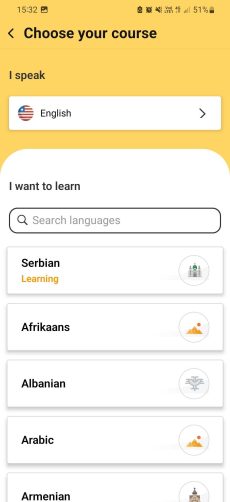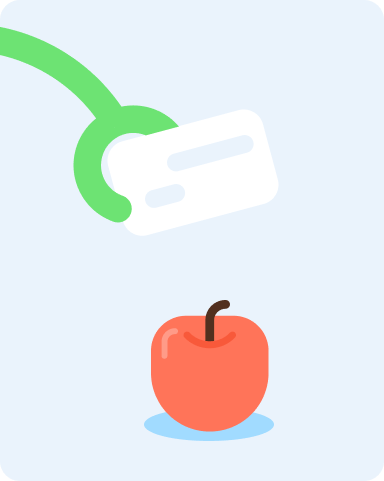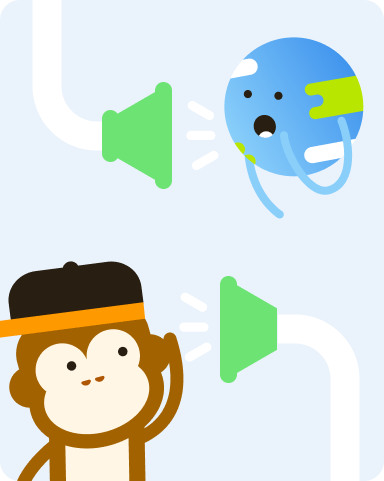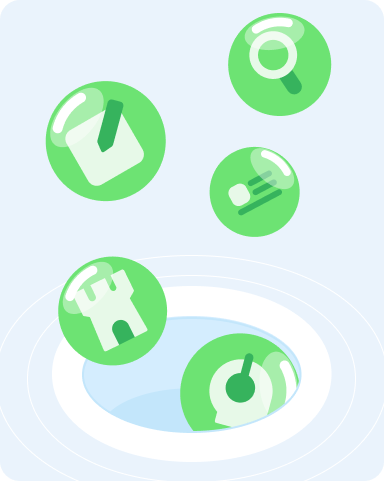Learn Serbian
with Ling
Use our comprehensive lessons, conversation topics, and more to connect with those closest to you
Used by 5M Ling Learners




What makes learning Serbian with Ling special
Interactive exercises
Elevate your Serbian pronunciation with our app’s interactive chatbot and enhance your listening skills with audio from native Serbian speakers
Engaging activities
Level up your Serbian with fun mini-games and our newest lesson review feature

Proven results
Backed by linguistic research, our learning methods can help you achieve fluency in record time
Mix of languages
Besides learning Serbian, you can choose from over 60 languages, both big and small

Master 4 language skills in 10 minutes a day




1-3 minutes to learn new vocabulary
3-5 minutes to review
3-5 minutes to test your listening skills
Done!
Join over 5 million language learners for a 100% guaranteed amazing language experience
Frequently asked questions about learning Serbian
Learning Serbian can be challenging for many reasons. Factors such as your native language, previous learning experience, and the amount of time and effort you dedicate to studying all play a role in determining the difficulty of learning Serbian. Learners often describe this language as one of the most challenging ones out there due to its complex grammar, verb conjugations, and pronunciation.
However, don't let the difficulty discourage you from learning Serbian. With the right resources, enough practice, and dedication, anyone can achieve it. Remember, if you approach your learning positively and find online resources, you can make the learning process easier and more enjoyable.
If you're feeling overwhelmed as a beginner, you can follow these tips to ease your language-learning journey.
-
Grammar: Serbian sentences follow the Subject-Verb-Object pattern. The nouns, verbs, pronouns, and adjectives all have distinctive grammatical patterns in Serbian, which is a complete and inclusive language.
-
Vocabulary: Memorize basic vocabulary first, such as greetings, directions, familial words, and so on. There is so much vocabulary, so practice with quizzes and flashcards from the Ling app to remember them easier.
-
Speaking/Listening: In terms of pronunciation, Serbian speakers tend to enunciate every letter. Follow their lead and make sure you know the dialectal differences between Torlakian and Shtokovian.
-
Reading/Writing: For the Serbian writing system, the locals mainly use Latin (abeceda) and Serbian Cyrillic (azbuka) interchangeably. Both alphabets can be found on street signs, buses, and government-based documents. Serbian locals suggest reading Serbian words in the exact way they are written. However, do note that some letters in Serbian do not appear in English.
No one can become a master of a new skill or language overnight. But is it necessary to go to Serbia to become fluent in Serbian? Absolutely not! If you want to become proficient in this beautiful language, there are tons of online resources available. Free Serbian lessons, language learning apps, and language exchange groups to practice with Serbian native speakers are some examples of resources that can help you stay motivated and engaged along the way.
To help narrow down your choices, we highly encourage you to use the Ling app.
Besides using an online learning resource, you can learn Serbian easier by:
-
Learning the alphabet first: This is because, without an idea of how to read or write Serbian Cyrillic, you'll be stuck at the basic level (A1).
-
Practicing writing sentences that incorporate gender noun endings and cases: Serbian, like many Indo-European languages, has three genders, and mastering them is crucial for effective communication.
-
Studying Serbian history: A lot of the cultural aspects of the Serbian language evolved from its long line of geopolitical changes.
-
Speaking with native Serbian speakers or with other Serbian learners: Speaking is a critical component of language learning, and regular practice with others can help you improve your fluency and build confidence.
-
Not stressing over minor mistakes: Learning a new language is tough for everyone, but as long as you put in the time and effort, you will see results.
According to the Foreign Service Institute (FSI), an average learner will take around 1,100 hours to become proficient in Serbian. However, your progress truly depends on your commitment to the language.
For Serbian, you’ll need to dedicate at least two years of consistent practice to achieve fluency. To make the starting process easier, we recommend paying attention to the most frequently used Serbian words in your first month of learning. That way, as you advance through Serbian language lessons, you won’t be clueless about basic vocabulary.
The average duration it’ll take to become fluent in a new language is something everyone wants to know, and that’s understandable. Most of us have routines and schedules to keep, so we need to know if learning a new language is a realistic goal. We’re here to tell you that you can learn Serbian, no matter your schedule. As long as you’re passionate and dedicated, there’s no need to be intimidated by the number of hours it’ll take.
Pros:
-
Convenience: You can learn Serbian from anywhere and anytime as long as you have an internet connection.
-
Flexibility: You can learn at your own pace and on your own schedule! It’s never been easier to balance your language learning with work, school, and everyday commitments.
-
Wide range of resources: Videos, podcasts, learning apps, and more; there are many resources according to your learning style and preferences that are ready for you to start learning Serbian.
-
Fun and engaging learning: If you are not into studying only with academic books, a gamified app like Ling will allow you to experience the fun way of learning languages.
Cons:
-
Lack of interaction with other people: There are few opportunities to interact with native speakers while learning online. This can make it harder for you to practice speaking and listening.
-
Technical Issues: Internet connectivity problems or software glitches can disrupt your learning and cause frustration.
-
Self-motivation: Since there are no teachers, tutors, or classmates to hold you accountable for your learning, it’s on you to stay on track and motivated until you reach your goal.
Serbian is the official language of Serbia, a Southeastern and Central European country with a population of approximately seven million people.
Putting aside its difficulty, Serbian is one of the most exciting languages to learn, and here's why.
-
Help You Learn Other Slavic Languages
Serbian is an excellent starting point for studying Slavic languages. If you're proficient in Serbian, chances are that you'll be able to learn Croatian, Bulgarian, or Russian much easier!
-
Get To Know Serbian People
Communicating directly with the locals is a great way to practice your speaking skills and form long-lasting relationships. Serbians will be both impressed by your skills and greatly appreciate your dedication to learning their language and Serbo-Croatian history.
-
Discover Serbian Literature, Arts, Music, And More
By immersing yourself in its literature, art, music, and more, you'll gain a deep appreciation for the country's rich history and traditions. Not only will this enhance your travels to Serbia or other Serbian-speaking countries, but it'll also help you create deeper connections with the locals.
Ready? Start exploring this language with Ling, a Serbian learning app that will provide a wide range of lessons and gamified exercises to ensure a fun and well-rounded learning experience.
It's crucial to begin with the basics of the Serbian alphabet and pronunciation to learn Serbian effectively. Once you have a solid grasp of the fundamentals, using a phrasebook can be beneficial for everyday communication. To make more significant progress, it's best to practice regularly with Serbian native speakers and immerse yourself in the language and culture as much as possible. Additionally, you can also utilize online learning resources to supplement your studies and improve your overall comprehension.
Ling's advice for properly learning Serbian is as follows:
-
Go for the basics: To lay a solid base for future learning, start by mastering the Serbian alphabet and fundamental grammar rules.
-
Pay extra attention to your pronunciation: Serbian pronunciation can be challenging, so it's important to practice regularly. Listen to audio resources and try to mimic the sounds. You may also record your own voice as well to identify what needs improvement.
-
Speak with native speakers: To increase your fluency and confidence in the language, immerse yourself in it by practicing with native speakers.
-
Use online resources: There are many free online resources available to help you learn Serbian. An excellent resource for learning Serbian online is the Ling app, which features engaging interactive courses and mini-games.
-
Set a study schedule: Consistency is key when it comes to learning Serbian. Commit to studying and practicing for at least 10 minutes every day.
-
Read in Serbian: Read articles, books, or other materials in Serbian to improve your vocabulary and comprehension skills.
-
Join a language exchange group: Joining groups or finding a language exchange partner online can provide opportunities for practice and feedback.















































